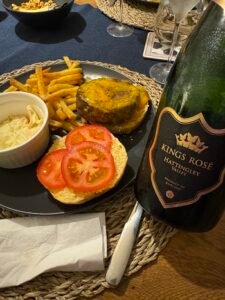After looking yesterday at the brief history, territory and climate as well as the grape varieties used for English Sparkling Wines, let’s take a look at the different styles and management of wine tourism.
We continue from there where we had stopped yesterday.
It’s all about balance

In the end, however, “it’s all about balance, isn’t it?“. A phrase uttered by Robert MacCulloch MW and winemaker at Hattingley, one of the larger and multi-contract wineries. It’s all about balance is the conclusion we drew after tasting the winery’s classic methods, including an impressive 2010 vintage (2013 disgorgement) from the company archives, while we were talking about… Amarone della Valpolicella. Yep, professional deformation mine, but in the end all the world is a country. This is confirmed by the fact that it is always a question of balance whether we are talking about a classic method or a big full-bodied red.
How then to find balance in English wines? According to Robert, and I trust him for the record, by looking for the right compromise between resting times on the lees, in his opinion ideally between 3 and 5 years, and a minimum of 6 to 12 months’ bottle corking at least. Il compromesso sta nel ridurre la sosta sui lieviti a favore del periodo con il sughero.
The styles
However, there are different styles and types of wine among English Sparklings. With more mature and oxidative tendencies. A mia modesta opinione, sebbene siano di impatto a una prima degustazione, risultano un po’ pesanti e destinate ad armonizzare poco con l’acidità al palato andando piuttosto in contrasto. La mia impressione è che sia più interessante sfruttare la sosta sui lieviti per bilanciare l’acidità piuttosto che creare sensazioni morbide con l’ossidazione. Anche perché di sostanze aromatiche da ossidare e di corpo da ingrassare ce n’è ben poco.
There are also more “modern,” snappy styles, from delicate noses but depth on tasting. Definitely sharper but integral and in my opinion definitely more interesting and easy to appreciate and understand. Really never mundane anyway.
In between are positioned experiments with Reserve wines from rests or fermentations in wood. Beve impegnative, anche nel prezzo, ma impressionanti per eleganza e equilibrio. Rappresentano al momento le spearheads of each winery’s production.

About the types instead you will find:
- Classic, which means the classic blend of the three grapes, tending to brut dosage. Si tratta del primo prodotto aziendale, il loro biglietto da visita per intenderci.
- Rosé, which can be from red grapes or from Chardonnay with red wine added.
- Blanc de Blancs and Blanc de Noirs tended to be reserved for more niche productions with a few special touches (see reserve wine).
Products can be millesimal or NV.
Sugar dosages tend to be always present for a balance argument.
Still in terms of style, one thing is giving pause for thought. Not without effort (the investments are really significant), several companies are opening their own production wineries by breaking away from larger companies that processed grapes for them by producing third-party labels.
Creating wineries from scratch involves a lot of economic and other efforts. But it does, however, allow them to range even further in the personalization and interpretation of their raw material. Experimenting on their own, where in a host winery it would not have been possible so widely. In search of their own identity and uniqueness.
Wine and wine tourism

With vineyards to be scouted here and there (you won’t find them everywhere like in Italy), and wineries that are gradually springing up there is ample room for development in wine tourism.
And here, dear Italians, we have something to learn. Even those without wineries have been able to develop hospitality in new and specially equipped locations. Tasting room, wine bar and wine shop, to close the circle some food proposals and the inevitable guided tour of the vineyards.
Well-defined wine tourism proposals, often run as a family but with great professionalism and passion. This was the case for All Angels, where a retired wife and husband now devote themselves to the countryside and hosting wine lovers on weekends by literally opening the doors of their home. Something similar, but more structured still, happens at Raimes, a winery established as the rib of a pre-existing, and still active, farm.
And with this info I introduce the last defining element of this new English “wine world.” Many families, whether already organized with a winery of their own or not, who invested in viticulture today were already pre-existing farms. Dal mondo agricolo quindi hanno intravisto un’opportunità in questa coltura, nuova per la campagna inglese, dedicandocisi con curiosità e spirito propositivo. Forti forse anche del fatto che renowned French Maisons are investing in this very territory buying land, planting vineyards and making products that are the offspring of expertise rooted in time.
There is also no shortage of still wines, especially whites and rosés. It must be said, however, that often this type of production is a bit premature. The demand is there but the types of grapes grown with that way they ripen dictated by the climate and the nature of the soils just seems to make them scream “sparkling wine base”. Data source and more info at winegb.co.uk.
For tastings we look forward to seeing you here on the site tomorrow.


